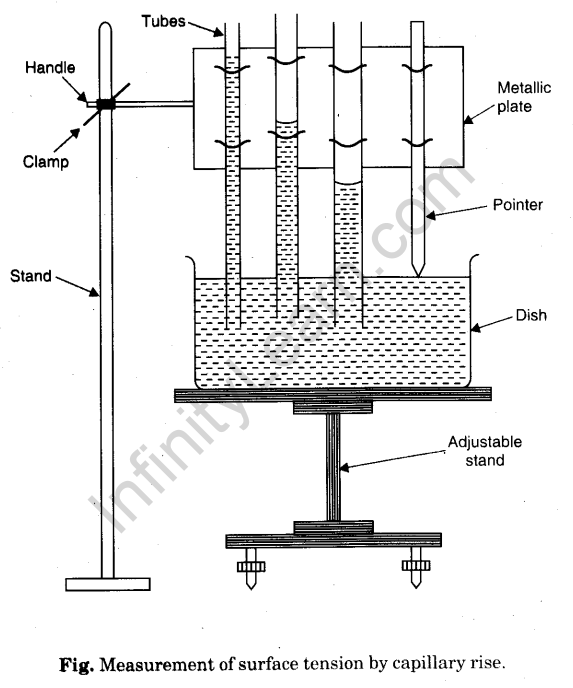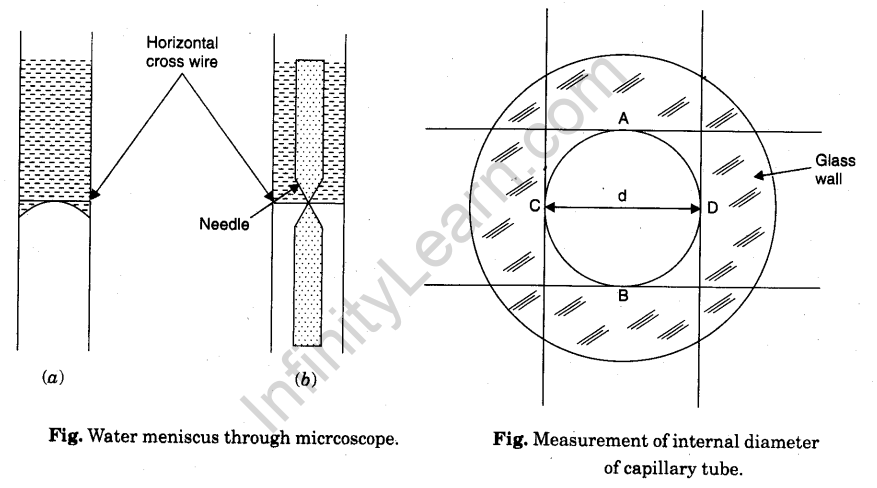To Study the Effect of Detergent on Surface Tension of Water by Observing Capillary Rise
Aim
To study the effect of detergent on surface tension of water by observing capillary rise.
Apparatus
Three capillary tubes of different radii and a tipped pointer clamped in a metallic plate with a handle, travelling microscope, clamp and stand, a fine motion adjustable height stand, a flat bottom open dish, clean water in a beaker, thermometer.
Theory
A detergent when added to distilled water reduces surface tension of water. If we use same capillary tube to study the rise of pure distilled water and then the rise of detergent mixed water (solution), we shall find that the rise will be less in case of solution. If quantity of detergent (solution concentration) is increased, rise will be still lesser.

Diagram


Procedure
(a) Setting the apparatus
1. Place the adjustable height stand on the table and make its base horizontal by level-ling screws.
2. Take dirt and grease free water in an open dish with flat bottom and put it on the top of the stand.
3. Take three capillary tubes of different radii (ranging from 0.05 mm to 0.15 mm).
4. Clean and dry them, clamp the capillary tubes in a metallic plate in order of increasing radius. Also clamp a pointer after third capillary tube.
5. Clamp the horizontal handle of the metallic plate in a vertical stand, so that the capillary tubes and the pointer become vertical.
6. So adjust the height of metallic plate that the capillary tubes dip in water in open dish.
7. Adjust the position of the pointer, such that its tip just touches the water surface.
(b) Measurement of capillary rise
8. Find the least count of the travelling microscope for the horizontal and the vertical scale. Record the same in the note-book.
9. Raise the microscope to a suitable height, keeping its axis horizontal and pointed towards the capillary tubes.
10. Bring the microscope in front of first capillary tube (which has maximum rise).
11. Make the horizontal cross wire just touch the central part of the concave meniscus seen convex through microscope.
12. Note the reading of the position of the microscope on the vertical scale.
13. Now move the microscope horizontally and bring it in front of the second capillary tube.
14. Lower the microscope and repeat steps 11 and 12.
15. Repeat steps 11 and 12 for third capillary tube.
16. Lower the stand so that pointer tip becomes visible.
17. Move the microscope horizontally and bring it in front of the pointer.
18. Lower the microscope and make the horizontal cross wire touch the tip of the pointer. Repeat step 12.
(c) Measurement of the internal diameter of the capillary tube
19. Place the first capillary tube horizontally on the adjustable stand.
20. Focus the microscope on the end dipped in water. A white circle (inner bore) surrounded by a green circular strip (glass cross section) will be seen.
21. Make horizontal cross-wire touch the inner circle at A. Note microscope reading on vertical scale.
22. Raise the microscope to make the horizontal cross-wire touch the circle at B. Note the reading (the difference gives the vertical internal diameter AB of the capillary tube).
23. Move the microscope on horizontal scale and make the vertical cross wire touch the inner circle at C. Note microscope reading on horizontal scale.
24. Move the microscope to the right to make the vertical cross-wire touch the circle at D. Note the reading (the difference gives the horizontal internal diameter CD of the capillary tube).
25. Repeat steps 19 to 24 for other two capillary tubes.
26. Note temperature of water in dish.
27. Record your observations as given ahead.
28. Take a known volume of distilled water from same sample.
29. Dissolve a small known mass of a detergent in the water to make a dilute solution.
30. Find the rise of the solution in same capillary tube. The rise will be less than that for pure water.
31. Add double mass of detergent in same volume of water to have a solution with double concentration.
32. Find the rise of this concentrated solution in same capillary tube. The rise will be still lesser.
33. Repeat with solution of same detergent having increased concentration. Rise will decrease as concentration increases.
Observatin
The rise in capillary tube decreases with addition of detergent in pure water. With more addition of detergent, rise becomes lesser and lesser.
Result
The detergent reduces the surface tension of water.
Precautions
- Capillary tube and water should be free from grease.
- Capillary tube should be set vertical.
- Microscope should be moved in lower direction only to avoid back lash error.
- Internal diameter of capillary tube should be measured in two mutually perpendicular directions.
- Temperature of water should be noted.
Sources of error
Water and capillary tube may not be free from grease.




